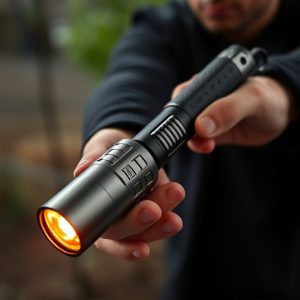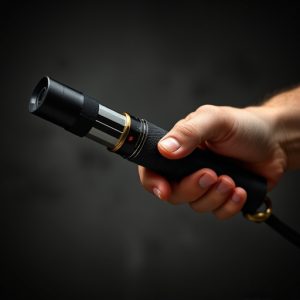Modern Self-Defense: The Evolving Role and Use of Expandable Batons in Law Enforcement
Self-defense expandable batons are a critical component of modern law enforcement toolkits, serving…….
Self-defense expandable batons are a critical component of modern law enforcement toolkits, serving as non-lethal alternatives to manage confrontational situations effectively. These batons feature a hinge mechanism that allows them to extend from a compact form into a longer weapon for precise strikes at a distance, making them ideal for tight spaces and scenarios where firearms are not an option. They undergo rigorous training programs to ensure officers deploy them with restraint and accuracy, reflecting their strategic inclusion in law enforcement gear due to their compactness, legal status, and adaptability to various conflict resolution needs. The batons are made from high-strength materials like aerospace aluminum or reinforced glass-filled nylon, designed for durability and resilience. They come in various lengths, with features such as rubberized segments to mitigate harm. The latest models offer enhanced kinetic energy, ergonomic enhancements, and shock-absorbing properties, aligning with contemporary law enforcement's focus on de-escalation and appropriate force application. Training for officers using self-defense expandable batons is extensive, covering deployment, retraction, and precision strikes in diverse scenarios. Legal restrictions and departmental policies are integral to the correct use of these batons, ensuring compliance with local, state, and federal laws. Every use is meticulously recorded to maintain transparency and accountability within law enforcement practices.
In modern law enforcement, officers are equipped with a variety of tools to ensure their safety and maintain public order. Among these, self-defense expandable batons stand out as versatile and effective instruments. This article delves into the multifaceted role of these devices within the field, examining their key features, evolution, and best use practices. We will explore how expandable batons have become integral to officers’ defensive strategies while adhering to legal standards. From assessing their design advancements to understanding the intricacies of training, this piece offers a comprehensive overview of the self-defense expandable baton’s place in contemporary law enforcement arsenals.
Understanding the Role of Self-Defense Expandable Batons in Law Enforcement
Self-defense expandable batons play a crucial role in modern law enforcement arsenals, offering a versatile tool for officers to handle a variety of confrontational situations. These collapsible batons are designed with a hinge mechanism that allows them to extend from a compact form into a longer, more effective weapon. When deployed, they can deliver controlled strikes at a distance, providing a non-lethal means to subdue an aggressor and maintain personal safety without resorting to lethal force. The effectiveness of expandable batons lies in their ability to neutralize threats quickly and from a safe distance. They are particularly useful in confined spaces or situations where the use of firearms is not advised. Law enforcement agencies often train officers on the proper techniques for deploying these batons, ensuring they can effectively use them as an extension of their physical presence. This training emphasizes the importance of restraint and precision, as the baton’s impact can incapacitate an assailant with minimal force required. The choice to include a self-defense expandable baton in an officer’s gear kit is strategic, considering its compactness, legality, and effectiveness in various scenarios. It complements other law enforcement tools, creating a comprehensive approach to personal security that aligns with the principles of community policing and non-lethal conflict resolution.
Key Features and Specifications of Modern Expandable Batons
Modern law enforcement gear is continually evolving to meet the diverse demands of field operations, and this evolution is particularly evident in the design of expandable batons. These versatile self-defense tools are an indispensable part of a police officer’s arsenal due to their compact size when retracted, which allows for easy carry without compromising on effectiveness. When deployed, these batons rapidly extend to form sturdy, durable rods capable of delivering controlled force in self-defense situations. A key feature of modern expandable batons is their robust construction, typically made from high-strength aerospace aluminum or reinforced glass-filled nylon, ensuring durability and longevity under the rigors of field use. They are engineered to be lightweight yet resilient, providing officers with a reliable impact weapon that can be wielded with one hand.
In terms of specifications, contemporary expandable batons come in various lengths when extended, with common models offering 16, 20, or 26-inch lengths upon activation. The activation mechanism itself is critical; it must be reliable and user-friendly to allow for quick deployment without manual dexterity being a barrier. Many modern batons feature a locking system that secures the baton at its extended length until manually unlocked, ensuring safety during transportation and storage. Additionally, these batons often incorporate an elastic band system that returns the baton to its compact form after use, which is both time-saving and efficient. Safety features such as rubberized tips or segments help minimize the risk of injury to suspects and bystanders, aligning with modern law enforcement’s commitment to de-escalation and proportional force. Other specifications to consider include the baton’s weight, balance, grip texture for optimal control, and any additional training or certification required for use, which can vary by jurisdiction.
The Evolution of Expandable Baton Designs for Enhanced Effectiveness and Safety
Over the years, the design and functionality of expandable batons have undergone significant advancements, reflecting the evolving needs within law enforcement for both self-defense and safety. Traditionally used as a tool to subdue threats at a distance without lethal force, modern expandable batons have become more sophisticated. They now feature mechanisms that allow for smoother and faster deployment, which can be critical in dynamic confrontation situations. The evolution of these devices has led to improved effectiveness, with some models boasting enhanced kinetic energy upon expansion, enabling officers to neutralize threats more efficiently while minimizing the risk of injury to both the subject and themselves.
The integration of ergonomic designs and materials that absorb shock has further refined the expandable baton’s role in self-defense. These enhancements not only ensure the baton is effective as a deterrent but also protect the user from overexertion or injury during use. Training and policies have been updated to reflect these changes, ensuring that law enforcement personnel are well-equipped with the knowledge and skills required to handle expandable batons effectively. As a result, these tools now stand as a testament to innovation in self-defense technology within the realm of law enforcement gear.
Training and Best Practices for Effective Use of Self-Defense Expandable Batons by Officers
Law enforcement officers frequently encounter scenarios where they must protect themselves and others, often in high-stress situations. The self-defense expandable baton serves as a crucial tool in such instances, offering a balance between control and effectiveness. Training with self-defense expandable batons is paramount to ensure officer safety and the protection of public security. Officers must undergo rigorous training that includes not only the mechanical operation of deploying and retracting the baton but also the mastery of precise strikes to incapacitate an assailant without causing unnecessary harm. This training encompasses a variety of scenarios, including crowd control, where the baton’s reach can be a significant advantage, as well as close-quarters combat where its compact form is beneficial.
Best practices for effective use of self-defense expandable batons emphasize situational awareness and de-escalation techniques. Officers are trained to assess the threat level and to apply non-lethal force proportionally to the threat. It is essential that officers are familiar with legal guidelines and departmental policies regarding the use of force, as these dictate when and how the baton can be employed. Regular drills and continuous training ensure that officers maintain proficiency with the expandable baton, allowing for confident and judicious use in real-world situations. Continuous practice also helps to mitigate the risk of accidents or misuse, reinforcing the importance of ongoing education and skill development in law enforcement.
Legal Considerations and Regulations Governing the Use of Expandable Batons in Law Enforcement Operations
Law enforcement officers are entrusted with maintaining public safety, which often necessitates the use of specialized equipment for self-defense and crowd control. Among such tools, expandable batons have become a common component in an officer’s gear due to their compact design and effectiveness in self defense scenarios. The legal framework governing the use of these batons is stringent, reflecting the balance between the rights of individuals and the need for officers to protect themselves and the public. Regulations vary by jurisdiction but generally require thorough training and clear policies that dictate when and how an expandable baton can be employed. Officers must undergo specialized training to ensure they understand the proper use, potential risks, and legal implications of deploying an expandable baton in the line of duty. This training is crucial as it ensures compliance with local, state, and federal laws that regulate the use of such devices. The regulations often emphasize the principle of proportionality, stipulating that the force used must be reasonable and necessary given the circumstances. Additionally, any deployment of an expandable baton must be documented, providing a transparent record for accountability and review by oversight bodies. These measures underscore the commitment to uphold legal standards while equipping law enforcement with tools like self defense expandable batons that are essential for their safety and effective in executing their duties.


